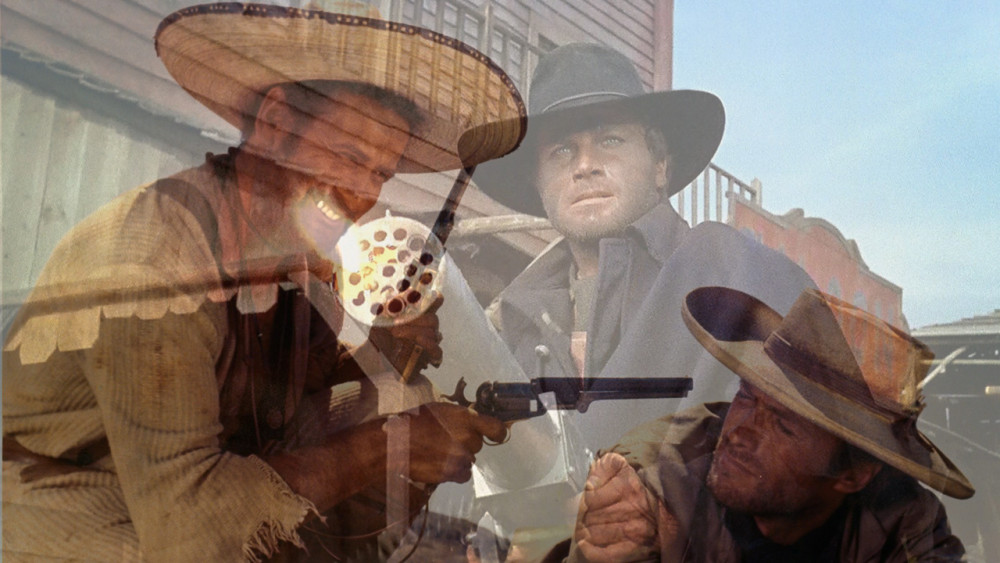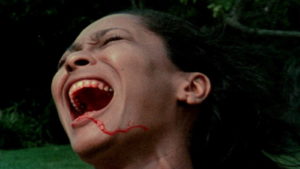
Damn there were a lot of spaghetti westerns in 1966! We’ve already seen two beaten out in this Tournament of Films (The Big Gundown, Navajo Joe) while Django storms into it’s next round to stand-off against the spaghetti western to end all spaghetti westerns: Sergio Leone’s seminal The Good, the Bad and the Ugly!
If you haven’t seen The Good, the Bad and the Ugly by now, chances are it’s that daunting movie on your watchlist you’re waiting to scratch off. Widely considered one of greatest movies ever made (it’s been in the IMDB top 10 since the internet was born), there’s nothing I can say about it that hasn’t already been said. It cemented Clint Eastwood, Sergio Leone and Ennio Morricone into the pantheon of legends in front of and behind the camera. It crystallized a cinematic language that would be essential in the development of action cinema. It has influenced more filmmakers around the world than I dare count. Even Quentin Tarantino, the man who has more favorite films that anyone on the planet, can’t bring himself to crown anything else as his number one. It’s a keystone movie, beloved by hardcore cinephiles and casual moviegoers alike. No matter how many times you revisit it, the aesthetic impact never falters. Like it or not, this movie will outlive all of us. It’s a titan, yes, and a daunting movie to write about. But that isn’t to say it’s untouchable.
Watching and rewatching The Good, the Bad and the Ugly today is fun. Lots of fun. Fun is the key word here because unlike a lot of movie classics, Leone’s epic is first and foremost wholly entertaining. Running just shy of three hours, it’s hard to pinpoint another movie in ’66 (or any other year for that matter) that makes such mincemeat out of its mammoth running time. The movie is constantly moving, whether it’s being propelled by the performances, the music or the direction, it doesn’t matter. There’s an electricity to this movie so timeless and fierce that even today, 50 years later, it feels fresh and addictive. Leone’s confidence as a visual stylist and storyteller is at its peak here. Yes, he would go on to conquer with both Once Upon a Time in the West and Once Upon a Time in America, but this film feels like a true culmination of the ideas and intent that drove his first few movies. If you watch The Good, the Bad and the Ugly directly after its predecessors, A Fistful of Dollars and A Few Dollars More, you can see the director’s journey reach its zenith. After completing his Dollars trilogy, Leone seemed less interested in making mere entertainment. Both West and America demand your attention and patience before slowly rewarding it while Ugly just slaps you across the face and throws you onto a roller-coaster. By this point in his career, Sergio Leone knew how to make a killer western and he was damn happy to fire on all cylinders.
Leone’s aesthetic authority here is genuinely awesome. I challenge anybody to watch that final showdown in the graveyard and not feel invigorated by the sheer power of movies. This is a film so unafraid of bigness and opera that it becomes transcendent. Close-ups become the size of mountains, Morricone’s score whistles, screams and howls at you at the top of its lungs, looks between characters represent fucking life and death, do I really need to go on? When you break the technique down, it’s even more startling because of how experimental it is. Nobody was cutting and scoring movies like this anywhere else in the world. It’s pure expression and emotion. At times the film is nothing but five minutes of close-ups cutting between each other; eyes, fingers, eyes, fingers, eyes, fingers, eyes–all set to a blaring Morricone soundtrack that still dominates turntables and iPods to this day. The first time I saw The Good, the Bad and the Ugly, I remember thinking “Movies can do that?” It wasn’t my gateway drug, but it confirmed that this was to be the medium I would be in love with for the rest of my life.
Now if there’s one thing slightly detrimental to The Good, the Bad and the Ugly today, it’s the familiarity. Whether it’s directly or by proxy, anyone who has seen a few movies and knows Leone’s name can probably describe the movie’s aesthetic and vibe quite accurately. The movie might not be as surprising on first watch given that you’re seeing it through the lens of the endless films it’s influenced in the half-a-century since its release. The film still has impact, but I wonder how diluted that will become over the generations. Django, on the other hand, has the benefit of still feeling like a real discovery.
Director Sergio Corbucci might not have the aesthetic grandiosity of a Leone but his spaghetti western universe is still uniquely his own. As both Derek and Juan noted in their write-ups of Django and Navajo Joe, Corbucci’s west is a cold, cruel wasteland. Leone’s vistas promise adventure and treasure whereas Corbucci’s feel like stark graveyards of despair and depravity. The Good, the Bad and the Ugly begins with Eastwood’s Blondie shooting Tuco’s (Eli Wallach) hanging rope, saving his life in the process (albeit for his own selfish reasons) while Django opens with its titular character dragging a coffin into town. He is the literal bringer of death. Despite their scoundrel shadings, you grow to like both Blondie and Tuco and enjoy their company. There are no characters with that kind of appeal in Django, which could also be titled merely The Bad and the Ugly. The only reason you warm to Franco Nero is because he’s not quite as despicable as everyone else. While some may find Django’s lack of moral centre off-putting, I imagine just as many will see it as an enticing alternative to Ugly‘s maximalism. This movie makes Leone’s depiction of violence look like Itchy and Scratchy. The appeal of Corbucci’s film is watching the ensemble of bastards and villains slowly tear one another apart. There’s a thrill in the harsh violence here that makes it harder to stomach than Ugly, but also grounds it with a reality and consequence that is more bracing. No sequence in Leone’s film matches the cruelty of the infamous ear-eating scene in Django. This is a positive though. Where Leone has bravura, Corbucci has bite.
One of Django’s most striking and innovative qualities is the sludgy production design. Most westerns–spaghetti and otherwise–revel in sand and sunlight, Corbucci replaces them with rain and mud. Characters are constantly wading through a sea of filth. Their clothes, boots and belongings are so smeared with the stuff that the saloon floorboards might as well be non-existent. When a character takes a bullet and goes down, they land with a splat. Given its modest budget in comparison to Ugly’s seemingly endless resources, it’s rather stunning how much is accomplished through Django’s distinctive art direction. The mud heightens the film thematically. The town takes on a mythic quality as if it is some kind of netherworld between death and damnation. Nobody escapes unmarked, not even the audience. You’ll walk out of Django with this hell-on-earth permanently stained on your consciousness. Even if you forget the particulars of the story, you won’t forget its texture.
While certainly a much-loved entry among spaghetti western aficionados, Django has remained a cult gem for most of its shelf-life until Quentin Tarantino threw it back into the spotlight via his 2012 retooling Django Unchained. Even though the film evaded English-speaking audiences for many years (it wasn’t released in the UK until Alex Cox screened it on his Moviedrome series in the early 90s), the film was a huge commercial success in Italy and spawned upwards of thirty sequels. The Good, the Bad and the Ugly has always been a widely imitated staple of film history whereas Corbucci’s western remains mostly untouched and idiosyncratic despite spawning its own sprawl of sequels and imitators. Its bleak outlook and harsh violence make it far more difficult to emulate. Even though Django Unchained was more explicit in its borrowing, Tarantino’s follow-up, The Hateful Eight, is absolutely indebted to Corbucci with its ragtag mass of dastardly bastards and unflinching malice. I imagine a whole new generation of moviegoers are discovering Corbucci now thanks to Tarantino but those expecting something in the vein of Leone will certainly be in for a surprise. Leone might stun you, but Corbucci will deliver the shock and horror.
It seemed obvious from the outset who the victor in this Mexican stand-off was going to be but I must admit, I came extremely close to giving the edge to the underdog. Recommending The Good, the Bad and the Ugly feels like a terribly boring and predictable thing to do. Django is the perfect wild card. It is a distinctive little film that has an elemental, almost immersive sense of surroundings and squalor. It is a far more serrated and vicious film than Leone’s which bodes well for mature audiences looking to get their teeth stuck into something mythic or symbolic. It definitely deserves attention outside of genre-savvy enthusiasts and soundtrack collectors bellowing Bacalov’s infectious theme song. All that being said; it’s not a perfect film and frankly, not for everyone. The Good, the Bad and the Ugly, however, has never done anything other than convince me it is a total masterpiece. A 1966 Tournament of Films that doesn’t feature The Good, the Bad and the Ugly in the finals just doesn’t sit right with me.
“You see, in this world there’s two kinds of people, my friend: Those with loaded guns and those who dig.” Sorry Django, you dig.
The winner: The Good, the Bad and the Ugly.
—
Both films are available for purchase or rent on home video. The Good, the Bad and the Ugly is available to stream on all major VOD platforms.
The Good, the Bad and the Ugly; directed by Sergio Leone; written by Agenorre Incrocce, Furio Scarpelli, Sergio Leone, Luciano Vincenzoni, Sergio Donati, Mickey Knox (English version); starring Clint Eastwood, Lee Van Cleef, Eli Wallach; 177 minutes.
Django; directed by Sergio Corbucci; written by Bruno Corbucci and Sergio Corbucci; starring Franco Nero, Loredana Nusciak, José Badalo, Angel Alvarez, and Eduardo Fajardo, 90 minutes.



 Derek
Derek
 Isabelle
Isabelle